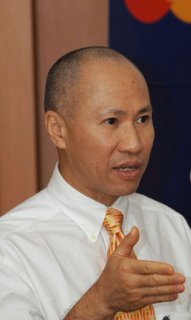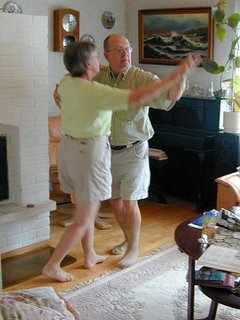
MY parents are both pushing 80. But it doesn’t show. They are both still active—my father still drives out to the grocery or drugstore, while my mother still does the marketing and goes out with her friends often. Both spend quite a sum on food (eating out or taking out), medicines, clothes, even junk food, every month.
And yet, I hear them complain all the time about the noise in the malls, or the loud music at restaurants, or how some store outlets don’t even recognize the senior citizen’s discounts mandated by law. Places with loud music—and there seems to be more and more of these—are unfriendly and inhospitable venues for senior citizens. My mother and her amigas, also don’t seem to have elderly-friendly activities to undertake— discounting ballroom dancing—and usually just end up having lunch as a major activity every month.
Unless it’s an arthritis medicine, an adult diaper or a hospital, there are really not many products geared toward the elderly generation, dubbed the “silver market” by Dr. Yuwa Hedrick-Wong, an economic adviser to MasterCard Worldwide in Asia Pacific. Dr. Yuwa has just come out with a book entitled The Glittering Silver Market, which chronicles the rise of the elderly consumers in Asia, and the exciting opportunities created for companies, given that these consumers have relatively high spending power.
 In his book, and during a recent roundtable discussion in Singapore with select journalists from around the region, Yuwa outlines startling facts:
In his book, and during a recent roundtable discussion in Singapore with select journalists from around the region, Yuwa outlines startling facts:• Due to the wider accessibility to healthcare, and a better psychology, human beings live longer, and are active beyond the average retirement age of 65. “The elderly are living healthier and leading more active lives,” said Yuwa, giving rise to the phenomenon called “compression of morbidity.” He said this trend shows that as life expectancy rises, the average age of the onset of chronic illnesses also rises. “The elderly get sick usually only a few months before they die,” he explained.
• The mindset of senior citizens is now changing. In a global survey, two-thirds of the elderly beyond 65 felt these years as a “second opportunity in life.” “They have a desire to do other things,” he added.
• Women will outnumber the men in most of the countries included in the book, except for India. From a consumer market perspective, this is an important development as “women can bounce back from life and become active in the social network,” thus maintaining their place as consumers, according to Yuwa.
• As more people move from rural areas to urban areas—estimated at 90,000 per day, every day in Asia—the elderly population growth as a market will be more evident.
• Despite the traditional close ties among Asian families, across generations, more “silvergenerarians” now prefer to live on their own, away from their children.
• The discretionary spending of the elderly household in emerging Asia (China, Indonesia, Malaysia, the Philippines) is projected to rise to $430 billion by 2015, from $153 billion in 2005.
What this means
It was surprising for me to discover that of all the markets covered in the book, the Philippines has the youngest average age at only 26 in 2005, which MasterCard projects will rise to 28 in 2015. (Japan, expectedly, is the oldest, with one out of five Japanese now over 65.)
It is perhaps because of the relative youth of the Filipinos that local businesses cater mostly to the younger, so-called MTV generation, which has to be fed loud rock or heavy metal music all the time for them to enjoy shopping, dining and spending (mostly their parents’ money, of course.)
Companies spend billions of pesos in marketing and advertising to the youth as they are seen as a segment demanding the fastest turnover of consumer goods. Just look at how many times cell-phone companies or telecom providers come out with new phone models every three months. The youth get easily tired of their “stuff” and want newer products, no matter the cost. All they have to do is charge their purchases.
 Yet it cannot be denied that the elderly Filipino market also presents a good-sized challenge to local businesses. By 2015, the silvergenarians are estimated to total 5 million, or almost 40 percent of the projected total population of 13 million, from 3.4 million, or 38 percent of the 9 million total population, in 2005.
Yet it cannot be denied that the elderly Filipino market also presents a good-sized challenge to local businesses. By 2015, the silvergenarians are estimated to total 5 million, or almost 40 percent of the projected total population of 13 million, from 3.4 million, or 38 percent of the 9 million total population, in 2005.According to Yuwa, of the estimated $153-billion discretionary spending of elderly households in emerging Asia, Filipinos accounted for $1.95 billion in 2005. Of this amount, the largest chunk went to dining and entertainment at $0.9 billion or P4.5 billion.
Every year, this discretionary spending is estimated to grow by 13.4 percent, reaching almost $5 billion by 2015. The largest growth, at 11.4 percent, would be seen in spending on auto, personal computers, mobile phone, and others at $0.2 billion or P10 billion.
Yuwa noted the large contribution of overseas Filipino workers in supporting the elderly in the Philippines.
“The vast majority of these overseas workers leave behind their spouses and young children. In many instances both parents work overseas, leaving the young children at home. Thus, a situation is created in which the grandparents (and sometimes the granduncles and aunts) serve as surrogate parents for the children of overseas workers,” he said.
“The overseas remittances support the family, including the elderly who are at home taking care of the grandchildren. And, for the elderly themselves, their role as surrogate parents enables the parents to seek work abroad. It may not be ideal, but in many ways, this is a win-win situation for the elderly, the overseas workers and the children left behind.”
Because of the OFW situation, the spending power of the elderly, which include retired empty nesters, as well as old singles, is projected to grow to $6.8 billion by 2015, from $4.4 billion. Think of the marketing possibilities for this segment in the society!
Perhaps other businesses can take a cue from the local property market developers who are now actively seeking out the OFWs who want to retire in the Philippines and other foreign retirees, to sell their future projects. Ayala Land Inc., for one, is already designing a retirement village with European and Asian retirees in mind, with all the amenities needed by the elderly such as recreational facilities, telecommunication and Internet connections, a nearby hospital or a well-equipped onsite primary health facility.
“If I were a developer today, I would think of developing flats for the elderly. They don’t need much space but everything is geared toward the elderly—from the bathroom, the kitchen, but they only need one bedroom. I would build this facility right next to a good health center, fitness center, make it all convenient. These are all business opportunities,” Yuwa said.
Tourism
 Local tourism is another sector that will benefit immensely by targeting the elderly market, specifically those from Japan.
Local tourism is another sector that will benefit immensely by targeting the elderly market, specifically those from Japan.According to Yuwa, Japanese senior citizens come in second to the 35- to 45-year-olds in terms of frequency of overseas travel. Most of these Japanese elderly, he added, are women —whose travels are tied to a specific lifestyle interest. They like visiting, for instance, places of historical interest, cultural interest.
So as a tourism destination, they have to tap that growing trend, Yuwa advised. They have to preserve their historical sites of interest and make it easy to travel and visit. They should also have local museums and curators who can provide information and engage the elderly. Make resorts and hotels elderly-friendly, he said.
What’s more, Dr. Yuwa noted, these elderly Japanese women are making their bookings via the Internet. This alone already debunks the misconception that the elderly are afraid of new technology.
Other businesses that could benefit from catering to the elderly include recreational or sports facilities and elderly wellness management, where there is a rapidly increasing need for gerontologists or specialists in preventive medicine and wellness management who could help the elderly live healthier lives. These specialists include even nutritionists or exercise trainers, he clarified.
The challenge, of course, is developing the right products for the elderly, and not make them feel, well, old. Marketing specialists, if their clients do decide to sell to this niche market, may find themselves at a loss on how exactly to tap into the thoughts of the elderly.
“If you look at marketing today, the common practice is you do surveys, you do your focus group. But what do you do in a focus group? You invite a bunch of kids and I come in they start yapping and you watch and you record them. That may not work for people in their 60s and 70s. If you can tap into their existing social network, you can learn a lot,” said Yuwa.
He cited Intel as an example of the more progressive companies that are now turning their sights on the elderly market. In China, for example, Intel has employed an anthropologist to observe (“as if looking at the elderly as a different tribe of people”) and to apply scientific training to really understand how they live, how they behave, how they interphase with technology, he said. Intel found that this kind of setup actually scares them. “They hate it, but in another way, they love it,” Yuwa said.
My folks may perhaps be too befuddled to learn to use the Internet, but all I know is, they need and want to get out more but have few places to go.
If only local businessmen would be able to see them and those in their age group as a potent niche market, which can also give their business the margins needed to succeed. (Related story below.)
(My article was published in the BusinessMirror, Perspective, Oct. 10, 2006. Photo of Dr. Yuwa courtesy of MasterCard Asia/Pacific. Photos of retirees from www.greenmeadows.com.)
No comments:
Post a Comment